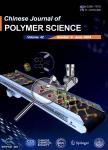A Self-Healing Elastomer with Extremely High Toughness Achieved by Acylsemicarbazide Hydrogen Bonding and Cu2+-Neocuproine Coordination Interactions
作者机构:Key Laboratory of High Performance Polymer Material and Technology of MOEDepartment of Polymer Science and EngineeringSchool of Chemistry and Chemical EngineeringNanjing University State Key Laboratory of Coordination ChemistryNanjing University
出 版 物:《Chinese Journal of Polymer Science》 (高分子科学(英文版))
年 卷 期:2024年第42卷第10期
页 面:1425-1434页
核心收录:
学科分类:081704[工学-应用化学] 07[理学] 08[工学] 070304[理学-物理化学(含∶化学物理)] 0817[工学-化学工程与技术] 0805[工学-材料科学与工程(可授工学、理学学位)] 080502[工学-材料学] 0703[理学-化学]
基 金:financially supported by the National Natural Science Foundation of China (No. 22075130) the Fundamental Research Funds for the Central Universities
主 题:Hydrogen bond Metal-ligand coordination Self-healing Ultra-tough elastomer
摘 要:Elastomers with high mechanical toughness can guarantee their durability during service life. Self-healing ability, as well as recyclability, can also extend the life of materials and save the consuming cost of the materials. Many efforts have been dedicated to promoting the mechanical toughness as well as the self-healing capability of elastomers at the same time, while it remains a challenge to balance the trade-off between the above properties in one system. Herein we proposed a molecular design driven by dual interactions of acylsemicarbazide hydrogen bonding and Cu2+-neocuproine coordination simultaneously. By introducing the reversible multiple hydrogen bonds and strong coordination bonds, we successfully fabricated an extremely tough and self-healing elastomer. The elastomer can achieve an impressive top-notch toughness of 491 MJ/m3. Furthermore, it boasted rapid elastic restorability within 10 min and outstanding crack tolerance with high fracture energy(152.6kJ/m2). Benefiting from the combination of dynamic interactions, the material was able to self-repair under 80 ℃ conveniently and could be reprocessed to restore the exceptional mechanical properties.



